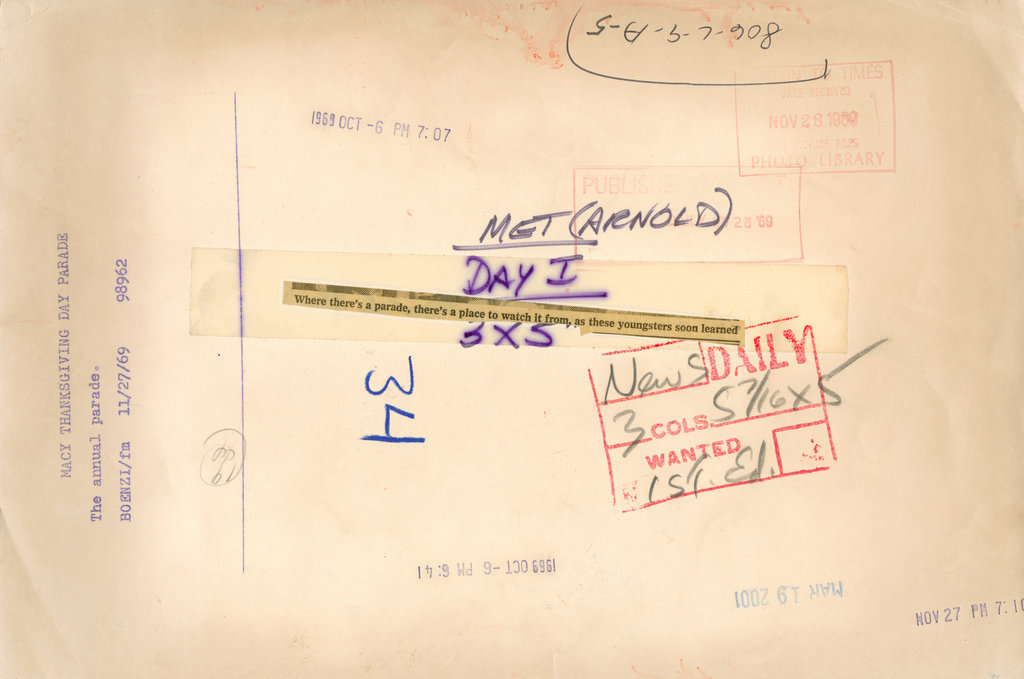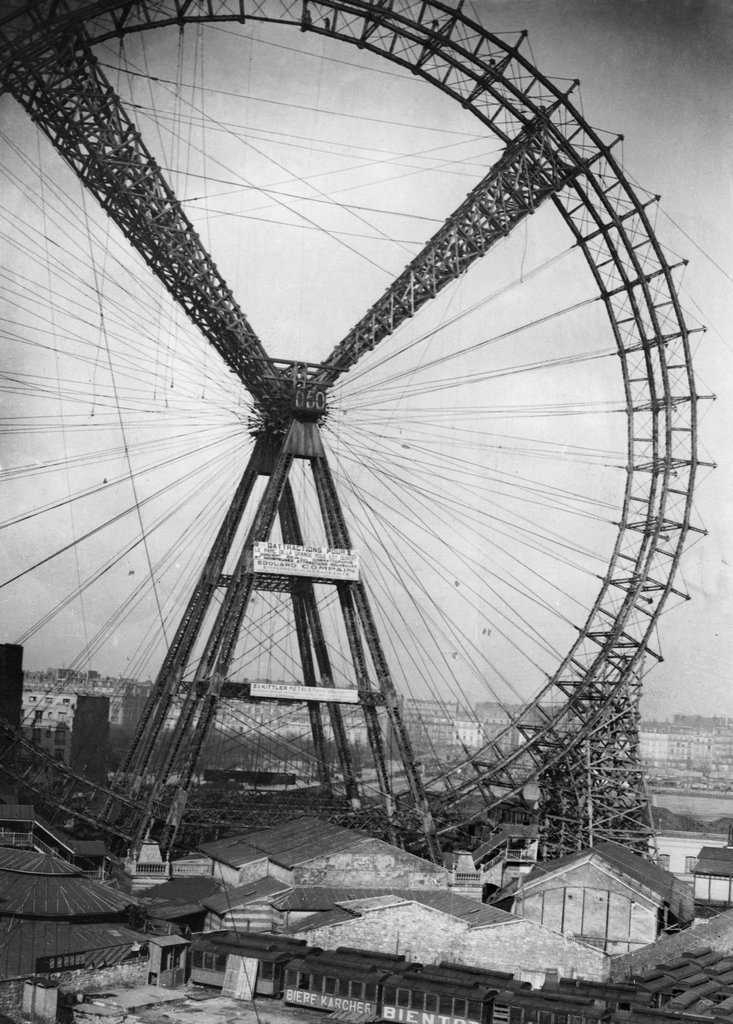The New York TimesThe Lively Morgue


Nov. 27, 1969: Youngsters found a good
spot to view the Macy’s Thanksgiving Day Parade, from atop a telephone
booth. “It was a day of abundance, not only of foods and goods, but of
emotions also,” reported The Times.
“Five raggedy children entered the Salvation Army cafeteria at 535 West
48th Street and, sitting among the weary old men and women who
traditionally feast with the army on this holiday, received heaps of
turkey and potatoes, peas and pumpkin pie.” Elsewhere, some G.I.s
boycotted turkey dinner, to protest the American war in Vietnam, as did
the Vegetarian Society of New York, to protest the exploitation of
animals. Photo: Neal Boenzi/The New York Times
spot to view the Macy’s Thanksgiving Day Parade, from atop a telephone
booth. “It was a day of abundance, not only of foods and goods, but of
emotions also,” reported The Times.
“Five raggedy children entered the Salvation Army cafeteria at 535 West
48th Street and, sitting among the weary old men and women who
traditionally feast with the army on this holiday, received heaps of
turkey and potatoes, peas and pumpkin pie.” Elsewhere, some G.I.s
boycotted turkey dinner, to protest the American war in Vietnam, as did
the Vegetarian Society of New York, to protest the exploitation of
animals. Photo: Neal Boenzi/The New York Times


April 12, 1965: Schoolchildren were
diverted from the American Museum of Natural History, as the museum,
“sorely beset by a sensational gem theft last fall and a murder in its
lobby during the winter, had another unhappy experience yesterday,” reported The Times.
A water main break flooded the basement, and the building was closed.
“The sidewalks were also flooded, providing tempting puddles” for
children arriving for their field trips, who were directed to the
adjacent, unaffected Hayden Planetarium. Photo: Eddie Hausner/The New York Times
diverted from the American Museum of Natural History, as the museum,
“sorely beset by a sensational gem theft last fall and a murder in its
lobby during the winter, had another unhappy experience yesterday,” reported The Times.
A water main break flooded the basement, and the building was closed.
“The sidewalks were also flooded, providing tempting puddles” for
children arriving for their field trips, who were directed to the
adjacent, unaffected Hayden Planetarium. Photo: Eddie Hausner/The New York Times


Oct. 18, 1977: “A four-alarm fire that
sent flames roaring at least 50 feet above roof-level in Greenwich
Village Monday night, raining embers over a wide area, was under
investigation yesterday ‘because of the large volume of fire on arrival
of the first equipment’ at the former warehouse,” reported The Times.
The building had been set to be converted from lofts to apartments
under the new owner, Roy Kalimian. “Mr. Kalimian, owner of the burned
building, is a brother and partner of Abi Kalimian, owner of 12 Jones
Street, also in the West Village, which went up in another spectacular
blaze last January, just before conversion from lofts to apartments, a
conversion that is still under way.” Photo: Paul Hosefros/The New York Times
sent flames roaring at least 50 feet above roof-level in Greenwich
Village Monday night, raining embers over a wide area, was under
investigation yesterday ‘because of the large volume of fire on arrival
of the first equipment’ at the former warehouse,” reported The Times.
The building had been set to be converted from lofts to apartments
under the new owner, Roy Kalimian. “Mr. Kalimian, owner of the burned
building, is a brother and partner of Abi Kalimian, owner of 12 Jones
Street, also in the West Village, which went up in another spectacular
blaze last January, just before conversion from lofts to apartments, a
conversion that is still under way.” Photo: Paul Hosefros/The New York Times


Dec. 18, 1969: A neglected block in
Brownsville, Brooklyn, where a nationwide Model Cities program — which
aimed to bring a holistic improvement regimen to selected neighborhoods
in 52 cities — was seen as stumbling. “Half of the program’s first year
is gone,” The Times reported,
“but only $7.7 million of the year’s allocation of $29 million in
Federal funds have been spent.” The mayor blamed a heavy-footed city
bureaucracy. “The mood is typified by Prospect Place in Brownsville,
flanked by desolate acres of rubble-strewn lots,” the story read.
“Rotted tenements have been torn down, but almost nothing is being built
because contractors’ bids have come in above the per-room cost ceilings
permitted by Congress for Federal projects.” Photo: Eddie Hausner/The New York Times
Brownsville, Brooklyn, where a nationwide Model Cities program — which
aimed to bring a holistic improvement regimen to selected neighborhoods
in 52 cities — was seen as stumbling. “Half of the program’s first year
is gone,” The Times reported,
“but only $7.7 million of the year’s allocation of $29 million in
Federal funds have been spent.” The mayor blamed a heavy-footed city
bureaucracy. “The mood is typified by Prospect Place in Brownsville,
flanked by desolate acres of rubble-strewn lots,” the story read.
“Rotted tenements have been torn down, but almost nothing is being built
because contractors’ bids have come in above the per-room cost ceilings
permitted by Congress for Federal projects.” Photo: Eddie Hausner/The New York Times


Sept. 12, 1960: “This will go down in
history as one of the biggest hurricanes that ever hit New York and the
metropolitan area,” said one meteorologist of Hurricane Donna, but some, including a few die-hards at a downtown bar, would not be discouraged from their afternoon tipple. Photo: Allyn Baum/The New York Times
history as one of the biggest hurricanes that ever hit New York and the
metropolitan area,” said one meteorologist of Hurricane Donna, but some, including a few die-hards at a downtown bar, would not be discouraged from their afternoon tipple. Photo: Allyn Baum/The New York Times


Sept. 14, 1944: An intrepid couple
braved high winds and rain as an unnamed hurricane (they did not start
giving names until 1950) threatened the East Coast. New York City was
spared the worst, but, as The Times reported later, Atlantic City’s boardwalk was destroyed, dozens were killed in five states and hundreds were left homeless. Photo: The New York Times
braved high winds and rain as an unnamed hurricane (they did not start
giving names until 1950) threatened the East Coast. New York City was
spared the worst, but, as The Times reported later, Atlantic City’s boardwalk was destroyed, dozens were killed in five states and hundreds were left homeless. Photo: The New York Times


Feb. 6, 1978: In New York City, gale-force winds buffeted Midtown pedestrians during a storm that forced motorists to abandon their cars
and dropped more than 16 inches of snow on the city. “In Manhattan,
midtown hotels reported virtually every room rented by noon to people
who had decided they would not try to go back home last night,” The
Times reported. Photo: Mary Ann Hardiman/The New York Times
and dropped more than 16 inches of snow on the city. “In Manhattan,
midtown hotels reported virtually every room rented by noon to people
who had decided they would not try to go back home last night,” The
Times reported. Photo: Mary Ann Hardiman/The New York Times


Dec. 24, 1935: Though there were happy
frolics in Central Park on Christmas Eve, with new sleds put to use on
the week’s fresh snow, the news of the day carried headlines of a “voluntary exile” to England by Charles Lindbergh, his wife, Anne Morrow Lindbergh, and their 3-year-old son, Jon. Photo: The New York Times
frolics in Central Park on Christmas Eve, with new sleds put to use on
the week’s fresh snow, the news of the day carried headlines of a “voluntary exile” to England by Charles Lindbergh, his wife, Anne Morrow Lindbergh, and their 3-year-old son, Jon. Photo: The New York Times


Aug. 20, 1975: An enormous metal Whirl-a-Ride hurtled the young and the thrill-seeking through the late-summer air at the 130th Dutchess County Fair
in Rhinebeck, N.Y., which had themed days, animals, arts and crafts,
and more to offer. But as a fair manager explained in 1972, the county’s
identity — bucolic eden or bustling suburb — and thus the fair’s were in flux.
“We’re still trying to emphasize agriculture, but we’re really living
in the midst of an urban area,” S. Richard Lloyd said. “To a visitor
from the city, Mr. Lloyd’s words are hard to believe. The fairgrounds
abut a village of one-family houses surrounded by rolling fields,
orchards and small dairy farms,” The Times countered. Photo: Eddie Hausner/The New York Times
in Rhinebeck, N.Y., which had themed days, animals, arts and crafts,
and more to offer. But as a fair manager explained in 1972, the county’s
identity — bucolic eden or bustling suburb — and thus the fair’s were in flux.
“We’re still trying to emphasize agriculture, but we’re really living
in the midst of an urban area,” S. Richard Lloyd said. “To a visitor
from the city, Mr. Lloyd’s words are hard to believe. The fairgrounds
abut a village of one-family houses surrounded by rolling fields,
orchards and small dairy farms,” The Times countered. Photo: Eddie Hausner/The New York Times


April 3, 1921: The caption affixed to the back
reads, “The famous Ferris Wheel of Paris, denuded of all its passenger
cars, which are now to be used as the homes of French families returned
to the devastated regions.” It had been the tallest wheel in the world, debuting at the 1900 l’Exposition Universelle, till being dissembled and scrapped. Photo: The New York Times
reads, “The famous Ferris Wheel of Paris, denuded of all its passenger
cars, which are now to be used as the homes of French families returned
to the devastated regions.” It had been the tallest wheel in the world, debuting at the 1900 l’Exposition Universelle, till being dissembled and scrapped. Photo: The New York Times
No hay comentarios:
Publicar un comentario